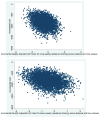SF-6D and EQ-5D result in widely divergent incremental cost-effectiveness ratios in a clinical trial of older women: implications for health policy decisions
- PMID: 21909728
- PMCID: PMC4508131
- DOI: 10.1007/s00198-011-1770-3
SF-6D and EQ-5D result in widely divergent incremental cost-effectiveness ratios in a clinical trial of older women: implications for health policy decisions
Abstract
Summary: Using two instruments (SF-6D and EQ-5D) to estimate quality adjusted life years (QALYs), we conducted an economic evaluation of a 12-month randomized controlled trial with a 12-month follow-up study in older women to evaluate the value for money of two doses of resistance training compared with balance and tone classes. We found that the incremental QALYs estimated from the SF-6D were two- to threefold greater than those estimated from the EQ-5D.
Introduction: Decision makers must continually choose between existing and new interventions. Hence, economic evaluations are increasingly prevalent. The impact of quality-adjusted life year (QALY) estimates using different instruments on the incremental cost-effectiveness ratios (ICERs) is not well understood in older adults. Thus, we compared ICERs, in older women, estimated by the EuroQol-5D (EQ-5D) and the Short Form-6D (SF-6D) to discuss implications on decision making.
Methods: Using both the EQ-5D and the SF-6D, we compared the incremental cost per QALY gained in a randomized controlled trial of resistance training in 155 community-dwelling women aged 65 to 75 years. The 12-month randomized controlled trial included a subsequent 12-month follow-up. Our focus, the follow-up study, included 123 of the 155 participants from the Brain Power study; 98 took part in the economic evaluation (twice-weekly balance and tone exercises, n = 28; once-weekly resistance training, n = 35; twice-weekly resistance training, n = 35). Our primary outcome measure was the incremental cost per QALY gained of once- or twice-weekly resistance training compared with balance and tone exercises.
Results: At cessation of the follow-up study, the incremental QALY was -0.051 (EQ-5D) and -0.144 (SF-6D) for the once-weekly resistance training group and -0.081 (EQ-5D) and -0.127 (SF-6D) for the twice-weekly resistance training group compared with balance and tone classes.
Conclusion: The incremental QALYs estimated from the SF-6D were two- to threefold greater than those estimated from the EQ-5D. Given the large magnitude of difference, the choice of preference-based utility instrument may substantially impact health care decisions.
Figures


Similar articles
-
Economic evaluation of dose-response resistance training in older women: a cost-effectiveness and cost-utility analysis.Osteoporos Int. 2011 May;22(5):1355-66. doi: 10.1007/s00198-010-1356-5. Epub 2010 Aug 4. Osteoporos Int. 2011. PMID: 20683707 Free PMC article. Clinical Trial.
-
Impact of mapped EQ-5D utilities on cost-effectiveness analysis: in the case of dialysis treatments.Eur J Health Econ. 2019 Feb;20(1):99-105. doi: 10.1007/s10198-018-0987-x. Epub 2018 Jun 14. Eur J Health Econ. 2019. PMID: 29948432 Free PMC article.
-
Sustained economic benefits of resistance training in community-dwelling senior women.J Am Geriatr Soc. 2011 Jul;59(7):1232-7. doi: 10.1111/j.1532-5415.2011.03474.x. Epub 2011 Jun 30. J Am Geriatr Soc. 2011. PMID: 21718265 Free PMC article. Clinical Trial.
-
Validity and responsiveness of EuroQol-5 dimension (EQ-5D) versus Short Form-6 dimension (SF-6D) questionnaire in chronic pain.Health Qual Life Outcomes. 2013 Jul 1;11:110. doi: 10.1186/1477-7525-11-110. Health Qual Life Outcomes. 2013. PMID: 23815777 Free PMC article. Review.
-
Randomised clinical trial, observational study and assessment of cost-effectiveness of the treatment of varicose veins (REACTIV trial).Health Technol Assess. 2006 Apr;10(13):1-196, iii-iv. doi: 10.3310/hta10130. Health Technol Assess. 2006. PMID: 16707070 Review.
Cited by
-
Guided Internet-Based Cognitive Behavioral Therapy for Insomnia: Health-Economic Evaluation From the Societal and Public Health Care Perspective Alongside a Randomized Controlled Trial.J Med Internet Res. 2021 May 24;23(5):e25609. doi: 10.2196/25609. J Med Internet Res. 2021. PMID: 34028361 Free PMC article. Clinical Trial.
-
Economic evaluation of non-pharmacological interventions in Alzheimer's disease.Dement Neuropsychol. 2025 Jun 2;19:e20240219. doi: 10.1590/1980-5764-DN-2024-0219. eCollection 2025. Dement Neuropsychol. 2025. PMID: 40469246 Free PMC article.
-
Cost effectiveness of telecare management for pain and depression in patients with cancer: results from a randomized trial.Gen Hosp Psychiatry. 2014 Nov-Dec;36(6):599-606. doi: 10.1016/j.genhosppsych.2014.07.004. Epub 2014 Jul 19. Gen Hosp Psychiatry. 2014. PMID: 25130518 Free PMC article. Clinical Trial.
-
A systematic review of instruments for measuring outcomes in economic evaluation within aged care.Health Qual Life Outcomes. 2015 Nov 9;13:179. doi: 10.1186/s12955-015-0372-8. Health Qual Life Outcomes. 2015. PMID: 26553129 Free PMC article.
-
Cost-effectiveness of ablation of ventricular tachycardia in ischaemic cardiomyopathy: limitations in the trial evidence base.Open Heart. 2020 Jan 28;7(1):e001155. doi: 10.1136/openhrt-2019-001155. eCollection 2020. Open Heart. 2020. PMID: 32076562 Free PMC article.
References
-
- Claxton K, Sculpher M, Drummond M. A rational framework for decision making by the National Institute For Clinical Excellence (NICE) Lancet. 2002;360:711–5. - PubMed
-
- Fenwick E, Marshall DA, Blackhouse G, et al. Assessing the impact of censoring of costs and effects on health-care decision-making: an example using the Atrial Fibrillation Follow-up Investigation of Rhythm Management (AFFIRM) study. Value Health. 2008;11:365–75. - PubMed
-
- Neumann PJ, Greenberg D, Olchanski NV, et al. Growth and quality of the cost-utility literature, 1976–2001. Value Health. 2005;8:3–9. - PubMed
-
- Siegel JE, Weinstein MC, Russell LB, et al. Recommendations for reporting cost-effectiveness analyses. Panel on Cost-Effectiveness in Health and Medicine. JAMA. 1996;276:1339–41. - PubMed
-
- Brazier J, Roberts J, Tsuchiya A, et al. A comparison of the EQ-5D and SF-6D across seven patient groups. Health Econ. 2004;13:873–84. - PubMed
Publication types
MeSH terms
Grants and funding
LinkOut - more resources
Full Text Sources
Medical

